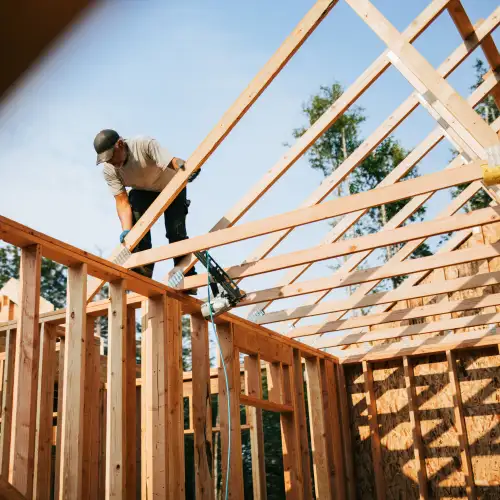What’s the difference between a 15 year and a 30 year mortgage?
It might seem straightforward, but the loan term is just one part of the bigger picture. The real impact lies in how each loan affects your monthly payment, interest rate and the total amount you’ll pay over the life of the loan. A 30 year vs. 15 year mortgage comparison can help you better understand how much interest you’ll pay, how quickly you’ll build equity and what you can afford based on your income and financial goals.
Which is better: 15 year mortgage vs. 30 year mortgage?
Good question. The answer to whether a 15 year mortgage or a 30 year mortgage is better depends on your individual situation. A shorter loan term means you’ll pay less in interest and own your home sooner—but it also comes with higher monthly payments. If you're focused on affordability and flexibility, a 30 year loan may offer more breathing room. Consider your personal finances, long-term goals and how each option fits into your broader real estate plan.
Loan term length
Just like the names suggest, a 15 year mortgage is paid off in 15 years, and a 30-year mortgage takes—you guessed it—30. The 30 year option is more popular with home buyers because stretching the payments out makes them easier to manage month to month. But with a 15 year mortgage, you’ll own your home outright a lot faster and build equity a lot quicker along the way.
Monthly payments
For many people, this is the number that counts most. One of the easiest ways to see how these two loan options stack up is through a monthly payment comparison. With a 15 year mortgage, your payments are higher because you’re knocking out the loan in half the time. The upside? More of your money goes straight toward the principal instead of interest. A 30 year mortgage, in contrast, comes with lower monthly payments, which can give you more breathing room in your budget or make it easier to qualify for a mortgage.
Total interest paid
If you didn’t account for this number, don’t worry—you’re not alone. A lot of people overlook total interest paid. So, while a 30 year mortgage might come with a smaller monthly payment, it’ll cost you more in the long run. Why? Because you’re stretching those payments out over three decades and often at a higher interest rate. On the flip side, a 15 year mortgage usually comes with a lower interest rate and much less total interest. You’re paying more each month, but you’re saving big overall.
Pros and cons of a 15 year mortgage
As they say, sometimes less is more. If you’ve got a bit of wiggle room in your budget, whether from a steady high income or a surprise windfall, a 15 year mortgage could be a smart way to make that extra cash work harder. It comes with some solid perks, but there are a few trade-offs to consider too. Let’s take a look at a few key factors.
Lower interest costs
If saving six figures in interest sounds good to you, a 15 year mortgage might be worth a closer look. These loans typically come with lower rates than 30 year options, and since you’re paying interest over a shorter period, the total cost of borrowing is much lower. For example, on a $400,000 loan with 20% down, a 15 year mortgage could save you over $250,000 in interest compared to a 30 year option (based on interest rates as of May 2025).
Faster payoff
Paying off your home in half the time doesn’t just sound good—it can fast-track your path to financial freedom. You’ll build equity quicker, which opens the door to more flexibility down the road through cash-out options like a HELOC. When the time is right, you can then tap into your home’s value for renovations, big purchases or your next big investment move.
Paying off your home in half the time doesn’t just sound good—it can fast-track your path to financial freedom.
Higher monthly payments
If you’re juggling student loans, car payments or childcare costs, a 15 year fixed rate mortgage might feel out of reach. That’s because the monthly payment is significantly higher due to the shortened mortgage term. While you’ll pay off your home faster and save on interest over the life of the loan, the upfront costs can strain your monthly budget.
Since your payments go toward both principal and interest, compressing repayment into a shorter window means writing bigger checks each month. If your personal finances are tight or your income fluctuates, it might be harder to qualify for a 15 year loan or sustain those higher monthly payments in the long term. A mortgage calculator can help you compare costs and see which option works better for your situation.
| Factor | 15-Year Mortgage | 30-Year Mortgage |
|---|---|---|
| Loan term | 15 years | 30 years |
| Monthly payments | Higher | Lower |
| Interest rates | Slightly lower | Slightly higher |
| Total interest paid | Less over time | More over time |
| Equity build-up | Faster | Slower |
Pros and cons of a 30-year mortgage
For many U.S. homeowners, the 30 year loan is still the standard—and for good reason. Spreading payments across 30 years results in lower monthly payments, freeing up cash for other goals like retirement, education or investments in real estate or other products and services.
However, this flexibility comes with trade-offs. You’ll pay more in interest payments over the life of the loan, and it’ll take longer to build equity. It’s important to weigh the short-term affordability against the long-term cost.
Lower monthly payments
The biggest perk of a 30 year mortgage? Lower monthly payments. Stretching the loan over a longer period makes each payment easier to handle, potentially helping you afford a home that wouldn’t be feasible with a shorter loan term.
Pro Tip
Just one extra payment per year on a 30 year mortgage can cut about 4–5 years off your loan. Just make sure your lender applies that extra payment to the principal, not future interest or upcoming installments.
Flexibility and budgeting
If having more flexibility in your budget matters to you, a 30 year term has the edge. With lower monthly payments, you’ll have more money to put toward retirement, invest in your future or simply cover everyday expenses like groceries and gas. Plus, because the monthly payment is lower, it’s often easier to qualify for a 30 year vs. 15 year mortgage.
More interest paid over time
A 30-year mortgage can ease the monthly pinch, but it comes at a long-term cost. Even with a slightly higher interest rate, paying interest for twice as long can add up to hundreds of thousands of dollars over the life of the loan. You’re essentially trading short-term affordability for long-term cost.
Which one should you choose?
Just like choosing the right home, there’s no one-size-fits-all answer here. But understanding how each loan option fits into your larger financial picture can help you decide with confidence. Let’s walk through a few considerations.
Factors to consider
- Monthly budget: Can you afford higher payments without sacrificing savings or other goals? If not, a 30 year loan may be the safer bet.
- Income stability: If your income fluctuates, the lower, more predictable payments of a 30 year loan offer more security.
- Financial goals: Want to build equity fast or be debt-free sooner? A 15 year mortgage gets you there quicker.
- Qualification: 15 year loans typically require higher income and lower debt, making them tougher to qualify for.
- Flexibility: A 30 year mortgage gives you wiggle room, and you can often pay extra to shorten the term if your budget allows.
Example scenarios: Which works best?
- A young couple buying their first home: If you’re a first-time home buyer deciding between a long-term vs. short-term loan, a 30 year mortgage is usually the better fit. It keeps monthly payments lower, which frees up cash for other priorities like car payments, student loans or handling unexpected homeownership costs. Plus, the flexibility helps when you’re still growing your income and figuring out long-term goals.
- A mid-career professional with a high income: A 15 year mortgage could be a smart move here. With a steady, higher income, you’re well-equipped to handle the larger payments. This option helps you build equity faster, pay less in interest and own your home outright sooner. It’s a solid play if you’re focused on long-term wealth building.
- A couple nearing retirement: It depends on your finances, but a 30 year mortgage often offers more breathing room. The lower monthly payments can help stabilize your budget, especially on a fixed income. However, if being mortgage-free by retirement is a priority and you can swing it, a 15 year term might be worth considering.
Ready to explore your options?
It’s not just the term to consider—it’s the type of loan, too. Take time to explore your options to find the one that fits your needs and financial goals best.







